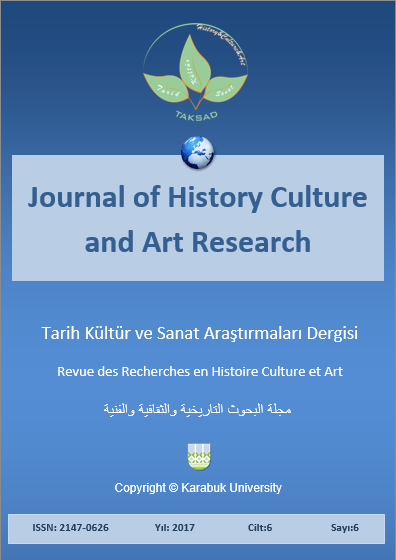A Comparative Study on the Origin and Variety of Motifs in Shahsavan Salt Bags and Caucasian Textiles
DOI:
https://doi.org/10.7596/taksad.v6i6.1358Anahtar Kelimeler:
Shahsavan- Caucasus- Salt bag- Textile- Motif.Özet
Shahsavan tribes of Iran and the Caucasus region have had considerable and often inevitable intercourse and associations during the history due to their common borders and special geographical locations. The result of this has been manifested in different forms of intermingled factors and elements, specifically the textiles of tribes and ethnic groups. The interactions of the mentioned realm, i.e. textile industry, have best been appeared in patterns, motifs, colors and compositions and weaving of the hand-woven textiles among which Shahsavan "salt bags" (NAMAKDᾹN) are a case in point. According to the facts and the importance of this subject, we can propose some questions as follows: What influences have the field of weaving had in these two regions as a result of their interactions and historical background? What are the motifs and their classifications in these two regions and which ones share common patterns? And which ones abound? Having been done in analytical and comparative method, the present research has examined the field of weaving in Shahsavan tribe with emphasis on its salt bags together with other Caucasian textiles (salt bags, etc.). The objectives of the research have been the study of the influences and interactions between the two regions and the recognition of patterns and motifs on their textiles. Finally, we can infer that the certain location of Iran and its common borders with the Caucasus besides tribal distribution of groups in northern and southern areas could be considered the reasons for cultural influences in the mentioned regions. The dominant motifs to be noticed here are dragons (S shape), diamonds and stars, crab-like and cross motifs as well as negative and positive spaces.
Referanslar
Aston, P. (2012). Dictionary of east carpet. Jamal-e-Honar publications, Tehran, Iran.
Goswam, K. K. (2008). Advances in Carpet Manufacture. Woodhead Publishing in Textiles, India.
Hall, A. & Vivoska, J. (1998). Kilim: history, design, weave and determination. Tehran publication, Iran.
Harvey, J. (1996). Traditional Textiles of Central Asia. Thames and Hudson publication, United Kingdom.
Hosseini, H.; Behnoud, H. & Baratali, M. (2008). Public dictionary of Iranian handmade. Ministry of Islamic cultural publication, Tehran, Iran.
Kaffel, R. (1998). Caucasian Prayer Rugs. Laurence King Publication, United Kingdom.
Kooper, J. (1999). Picture dictionary of traditional symbols. Farshad publications, Tehran, Iran.
Mahmudi, F. & Shayestehfar, M. (1989). Comparative study of the motifs of Shahsavan handmade and Caucasus nomad. Goljam publication, Iran.
Middleton, A.; Bird, H.; Ridley, T. & Merrell, J. (1996). Rugs & carpets: techniques, traditions & designs. Mitchell Beazley publication, United Kingdom.
Opie, J. (1992). Tribal rugs: nomadic and village weavings from the Near East and Central Asia. Canal and Stamperia publication, Spanish.
Sahabi, T. & Goodwright, C. (1998). Shahsavan. Jajim. CATO publication, Italy.
Stone, P. F. (1984). Rugs of the Caucasus. Structure and design publication, United Kingdom.
Stone, P. F. (1997). The Oriental rug lexicon. Thames and Hudson publication, United Kingdom.
Tanavoli, P. (1991). Bread and salt. Ketabsara publications, Tehran, Iran.
Tanavoli, P. (2001). Rural handmade of Varamin. Yasavoli publications, Tehran, Iran.
Tapper, R. (1997). Frontier Nomads of Iran: a political and social history of the Shahsevan (Vol. 7). Cambridge University Press, United Kingdom.
Wertime, J. T. (1998). Sumak Bags of Northwest Persia & Transcaucasia. Laurence King Publication, United Kingdom.
İndir
Yayınlanmış
Nasıl Atıf Yapılır
Sayı
Bölüm
Lisans
Tarih Kültür ve Sanat Araştırmaları Dergisi'nde yayımlanan tüm çalışmalar Creative Commons 4.0 CC-BY lisansı ile lisanslanmıştır.
Bunları yapmakta özgürsünüz:
- Bu eseri her boyut ve formatta paylaşabilir — kopyalayabilir ve çoğaltabilirsiniz.
- Materyalden Adapte et — karıştır, aktar ve eserin üzerine inşa et
- her türlü amaç için, ticari amaç da dahil
Alttaki şartlar altında:
Atıf — uygun bilgiyi, lisansa linki, and ve değişiklik yapıldıysa değişiklik bilgisinivermelisiniz. Sizi veya kullanımınızı lisansörün onayladığı bilgisini içermemek kaydıyla, size uygun şekilde bu işlemleri gerçekleştirebilirsiniz.
AynıLisanslaPaylaş — Eğer materyali karıştırdınızsa, aktardınızsa ya da materyalin üzerine çalıştınızsa, ancak aynı lisans ile dağıtabilirsiniz.
- Ek sınırlamalar yoktur — Lisansın izin verdiği hakları başkaları üzerinde kanunlarla ya da teknolojiyikullanarak sınırlayamazsınız.







